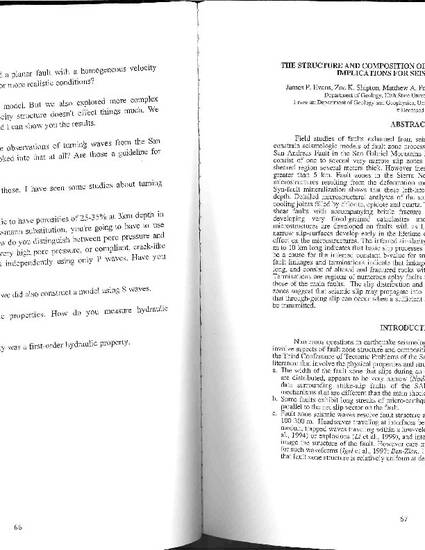
Contribution to Book
Evans et al., 2000.pdf
3rd Conference on Tectonic Problems of the San Andreas Fault System
(2000)
Abstract
- Field studies of faults exhumed from seismogenic depths provide useful data to constrain seismologic models of fault zone processes and properties. Data collected on tbe San Andreas Fault in the San Gabriel Mountains has shown that large-displacement faults consist of one to several very narrow slip zones embedded in a cataclastically defo1med sheared region several meters thick. However these faults have not been buried to depths greater than 5 km. Fault zones in the Sien-a Nevada, California allow us to study the microstructures resulting from the deformation mechanisms active at seismogen.ic depths. Syn-fault mineralization shows that these left-lateral strike-slip faults formed at 5-12 km depth. Detailed microstructural analyses of the small faults reveal that they evolved from cooling joints filled by cblorite, epidote and quartz. These joints were then reactivated to form shear faults with accompanying brittle fracture and cataclastic deformation, ultimately developing very fined-grained cataclasites and ultracataclasites. The shear-induced microstructures are developed on faults with as little as several mm of slip showing that nan-ow slip-surfaces develop early in the lifetime of these faults. Subsequent slip has little effect on the microstructures. The infeITed si.milarity of deformation mechanisms in faults 10 m to IO km long indicates that basic slip processes on the faults are scale invariant, and may be a cause for the infeITed constant b-value for small earthquakes. Analysis of map-scale fault linkages and terminations indicate that linkage zones are up to 400 m wide and 1 km long, and consist of altered and fractured rocks with numerous through-going slip surfaces. Ten-n.inations are regions of numerous splay faults that have cumulative offsets approaching those of the main faults. The slip distribution and structure of the terminations and linkage zones suggest that seismic slip may propagate into these zones of enhanced toughness, and that through-going slip can occur when a sufficient linkage of faults in the zone allow slip to be transmitted.
Keywords
- fautls,
- fault termination,
- fault gouge,
- exhumed
Disciplines
Publication Date
November, 2000
Editor
Gotz Bokelmann, Robert Kovach
Publisher
Stanford University Press
Series
Geological Sciences
Citation Information
James P. Evans, Zoe K. Shipton, Matthew A. Pachell, Siang Liim, et al.. "Evans et al., 2000.pdf" Stanford, CA3rd Conference on Tectonic Problems of the San Andreas Fault System Vol. XXI (2000) p. 47 - 81 Available at: http://works.bepress.com/james_evans/109/
